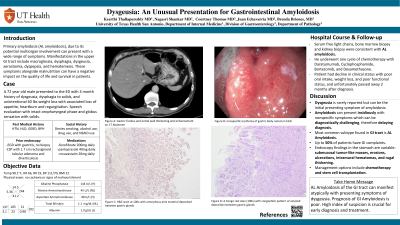Tuesday Poster Session
Category: General Endoscopy
P3423 - Dysgeusia: An Unusual Presentation for Gastrointestinal Amyloidosis
Tuesday, October 24, 2023
10:30 AM - 4:00 PM PT
Location: Exhibit Hall

Has Audio

Keerthi Thallapureddy, MD
UT Health San Antonio
San Antonio, TX
Presenting Author(s)
Keerthi Thallapureddy, MD1, Nagasri Shankar, MD1, Courtney Thomas, DO1, Brenda Briones, MD2, Juan Echavarria, MD2
1UT Health San Antonio, San Antonio, TX; 2University of Texas Health Science Center at San Antonio, San Antonio, TX
Introduction: AL amyloidosis, also known as primary amyloidosis, due to its potential multiorgan involvement can present with a wide range of symptoms based on the location of the pathology. Manifestations in the upper GI tract include macroglossia, dysphagia, dysgeusia, xerostomia, dyspepsia, and hematemesis. These symptoms alongside malnutrition can have a negative impact on the quality of life and survival in patients. We discuss a case of GI amyloidosis in an elderly male with an unusual presentation of dysgeusia and dysphagia with associated weight loss.
Case Description/Methods: A 72-year-old male with HTN, HLD and GERD presented to the emergency room for 3 months of dysgeusia, dysphagia, and unintentional 40 lbs weight loss. An upper endoscopy (EGD) at another institution 1-month prior was unremarkable. A CT abdomen demonstrated gastric fundus and antral wall thickening and enhancement. Repeat EGD was notable for areas of thickened folds with erythema, congestion, and nodularity in the greater curvature of the gastric body and congested duodenal mucosa (Figure A). Pathology demonstrated amyloid light chain deposition in the stomach and duodenal biopsies (Figures B,C). Serum free light chains were elevated, bone marrow biopsy showed a small population of kappa-restricted clonal plasma cells, all consistent with AL amyloidosis. A kidney biopsy for nephrotic range proteinuria also revealed amyloidosis. He was given 1 cycle of chemotherapy with Daratumumab, Cyclophosphamide, Bortezomib and Dexamethasone. Unfortunately, he continued to have a decline in clinical status with poor oral intake, weight loss and poor functional status. The patient passed away within 2 months of diagnosis.
Discussion: Amyloidosis can present insidiously with nonspecific symptoms affecting various organ systems, which can be diagnostically challenging and cause delays in diagnosis. The most common subtype of amyloidosis found in the GI tract is AL amyloidosis, and up to 50% of patients have GI complaints. Dysgeusia is rarely reported in literature but can be the initial symptom of amyloidosis due to macroglossia or secondary to deposition of amyloid in the tongue. EGD findings in the stomach are variable, including submucosal tumor-like masses, erosions, ulcerations, intramural hematomas, and rugal thickening. Treatment is with chemotherapy and stem cell transplantation. AL amyloidosis with GI involvement carries a worse prognosis making it crucial to keep a high suspicion for this condition for an early diagnosis and treatment.

Disclosures:
Keerthi Thallapureddy, MD1, Nagasri Shankar, MD1, Courtney Thomas, DO1, Brenda Briones, MD2, Juan Echavarria, MD2. P3423 - Dysgeusia: An Unusual Presentation for Gastrointestinal Amyloidosis, ACG 2023 Annual Scientific Meeting Abstracts. Vancouver, BC, Canada: American College of Gastroenterology.
1UT Health San Antonio, San Antonio, TX; 2University of Texas Health Science Center at San Antonio, San Antonio, TX
Introduction: AL amyloidosis, also known as primary amyloidosis, due to its potential multiorgan involvement can present with a wide range of symptoms based on the location of the pathology. Manifestations in the upper GI tract include macroglossia, dysphagia, dysgeusia, xerostomia, dyspepsia, and hematemesis. These symptoms alongside malnutrition can have a negative impact on the quality of life and survival in patients. We discuss a case of GI amyloidosis in an elderly male with an unusual presentation of dysgeusia and dysphagia with associated weight loss.
Case Description/Methods: A 72-year-old male with HTN, HLD and GERD presented to the emergency room for 3 months of dysgeusia, dysphagia, and unintentional 40 lbs weight loss. An upper endoscopy (EGD) at another institution 1-month prior was unremarkable. A CT abdomen demonstrated gastric fundus and antral wall thickening and enhancement. Repeat EGD was notable for areas of thickened folds with erythema, congestion, and nodularity in the greater curvature of the gastric body and congested duodenal mucosa (Figure A). Pathology demonstrated amyloid light chain deposition in the stomach and duodenal biopsies (Figures B,C). Serum free light chains were elevated, bone marrow biopsy showed a small population of kappa-restricted clonal plasma cells, all consistent with AL amyloidosis. A kidney biopsy for nephrotic range proteinuria also revealed amyloidosis. He was given 1 cycle of chemotherapy with Daratumumab, Cyclophosphamide, Bortezomib and Dexamethasone. Unfortunately, he continued to have a decline in clinical status with poor oral intake, weight loss and poor functional status. The patient passed away within 2 months of diagnosis.
Discussion: Amyloidosis can present insidiously with nonspecific symptoms affecting various organ systems, which can be diagnostically challenging and cause delays in diagnosis. The most common subtype of amyloidosis found in the GI tract is AL amyloidosis, and up to 50% of patients have GI complaints. Dysgeusia is rarely reported in literature but can be the initial symptom of amyloidosis due to macroglossia or secondary to deposition of amyloid in the tongue. EGD findings in the stomach are variable, including submucosal tumor-like masses, erosions, ulcerations, intramural hematomas, and rugal thickening. Treatment is with chemotherapy and stem cell transplantation. AL amyloidosis with GI involvement carries a worse prognosis making it crucial to keep a high suspicion for this condition for an early diagnosis and treatment.

Figure: Figure A: Upper Endoscopy findings of nonspecific erythema of gastric body
Figure B: An H&E stain at 100x with amorphous pink material deposited between gastric glands
Figure C: A Congo red stain (100x) with congophilic pattern of amyloid deposition between gastric glands
Figure B: An H&E stain at 100x with amorphous pink material deposited between gastric glands
Figure C: A Congo red stain (100x) with congophilic pattern of amyloid deposition between gastric glands
Disclosures:
Keerthi Thallapureddy indicated no relevant financial relationships.
Nagasri Shankar indicated no relevant financial relationships.
Courtney Thomas indicated no relevant financial relationships.
Brenda Briones indicated no relevant financial relationships.
Juan Echavarria indicated no relevant financial relationships.
Keerthi Thallapureddy, MD1, Nagasri Shankar, MD1, Courtney Thomas, DO1, Brenda Briones, MD2, Juan Echavarria, MD2. P3423 - Dysgeusia: An Unusual Presentation for Gastrointestinal Amyloidosis, ACG 2023 Annual Scientific Meeting Abstracts. Vancouver, BC, Canada: American College of Gastroenterology.
